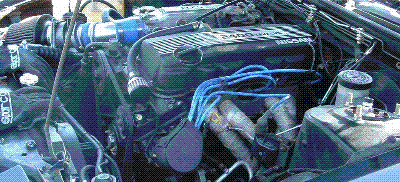
 |
|
|||||||
| Home | Rules & Guidelines | Register | Member Rides | FAQ | Members List | Social Groups | Calendar | Mark Forums Read |
| Tech Talk Technical Discussion About The Nissan 240SX and Nissan Z Cars |
 |
|
|
Thread Tools | Display Modes |
|
|
#1 |
|
Nissanaholic!
 Join Date: May 2003
Location: Bay Area, CA
Posts: 1,618
Trader Rating: (0)
        Feedback Score: 0 reviews
|
Ever wondered about exhuast back pressure?
What does it really mean? How can it hurt or help your performance?
This is an important question since many people claim this-and-that but have no real explanation other than dynos. Correct answers can explain why so-and-so sized exhuast systems will work for certain applications or regions of RPM. Let's get some replies first and then I can contribute what I know about it. |
|
|

|
| Sponsored Links |
|
|
#2 |
|
I hate you too...
 Join Date: Jul 2001
Location: Tampa, FL
Age: 42
Posts: 5,828
Trader Rating: (0)
           Feedback Score: 0 reviews
|
A dyno is a real world experience. It's also a source of empyrical data. I don't understand what you're talking about here. But what is the point of this thread? You making a buzz to show off what you know? Or to lure people to post misinformation so you can correct them? What is the game here?
My answer: To me, with my FI engine, backpressure is a PITA that needs to be eliminated. -Jeff
__________________
Whatup? |
|
|

|
|
|
#4 |
|
Nissanaholic!
 Join Date: May 2003
Location: Bay Area, CA
Posts: 1,618
Trader Rating: (0)
        Feedback Score: 0 reviews
|
And if you think this is a way to show off, it's not, and I never intended it to be.
If you think so, please delete the thread, I don't care. This is what I know, and someone correct me if I'm wrong: Net Power is different for NA and turbocharged engines. For NA, it's (indicated mean effective pressure) - |Intake Pressure - Exhuast Pressure| The |intake pressure - exhuast pressure| portion is the absolute difference and is called pumping losses. For a turbocharged engine, since intake pressure is raised by the turbine, pumping losses are added to the IMEP. Basically, the pumping losses become gains for the engine. Now, if pumping loss is intake pressure - exhuast, and intake pressure is approximately 0.95 atm at WOT, you basically want to minimize losses by letting that difference come as close to zero as possible. Now, my personal question is, is exhuast pressure exactly the same thing as back pressure? Or is back pressure just atmopheric pressure? I'm not 100% on this, and if anyone can help I would appreciate it. |
|
|

|
|
|
#8 |
|
Zilvia Junkie
 |
This was just covered by another thread really recently... ugh. This was the link the other user posted as explaination:
http://www.nsxprime.com/FAQ/Miscella...austtheory.htm |
|
|

|
|
|
#9 |
|
Nissanaholic!
 Join Date: May 2003
Location: Bay Area, CA
Posts: 1,618
Trader Rating: (0)
        Feedback Score: 0 reviews
|
Blues13, thanks for the link, it was informative. But it didn't answer my question. The only explanation they had of back pressure was
"The most efficient mufflers can only employ the same scavenging effect as a header, to help slightly overcome the loss of efficiency introduced into the system as back pressure." So is back pressure the action of cramming exhuast waves together? In engineering, I know back pressure is the pressure that the flow "dumps" in to. Such as a sub/super sonic nozzle. help? |
|
|

|
|
|
#10 | |
|
Nissanaholic!
 Join Date: May 2003
Location: Bay Area, CA
Posts: 1,618
Trader Rating: (0)
        Feedback Score: 0 reviews
|
Quote:
|
|
|
|

|
|
|
#11 |
|
Zilvia Junkie
 Join Date: May 2004
Location: Newark, Arkansas
Age: 41
Posts: 348
Trader Rating: (0)
 Feedback Score: 0 reviews
|
I'll try and explain. Okay say you had an open head. Just ports and then the air. As soon as the exhaust gases left the head they would be at atmospheric pressure. Now as an exhaust gets more restrictive, the gases try to move out quickly but can't move fast enough, and pressure starts building upstream. Like when you put part of your finger over the end of a water hose to make it shoot harder. You restricting the flow and causing back pressure. The pressure of the water behind the restriction grows, because it can't escape quickly enough. Backpressure is just the pressure that builds up behind restrictive parts of an exhaust. Is that a god explaination? I suck at explaining things sometimes.
-matt EDIT: They have testers you can get for exhaust back pressure. They screw into your o2 sensor bung, and measure usually between 7-10 psi. You're just measuring how much pressure is built up in the exhaust, due to restriction.
__________________

|
|
|

|
 |
| Bookmarks |
| Thread Tools | |
| Display Modes | |
|
|